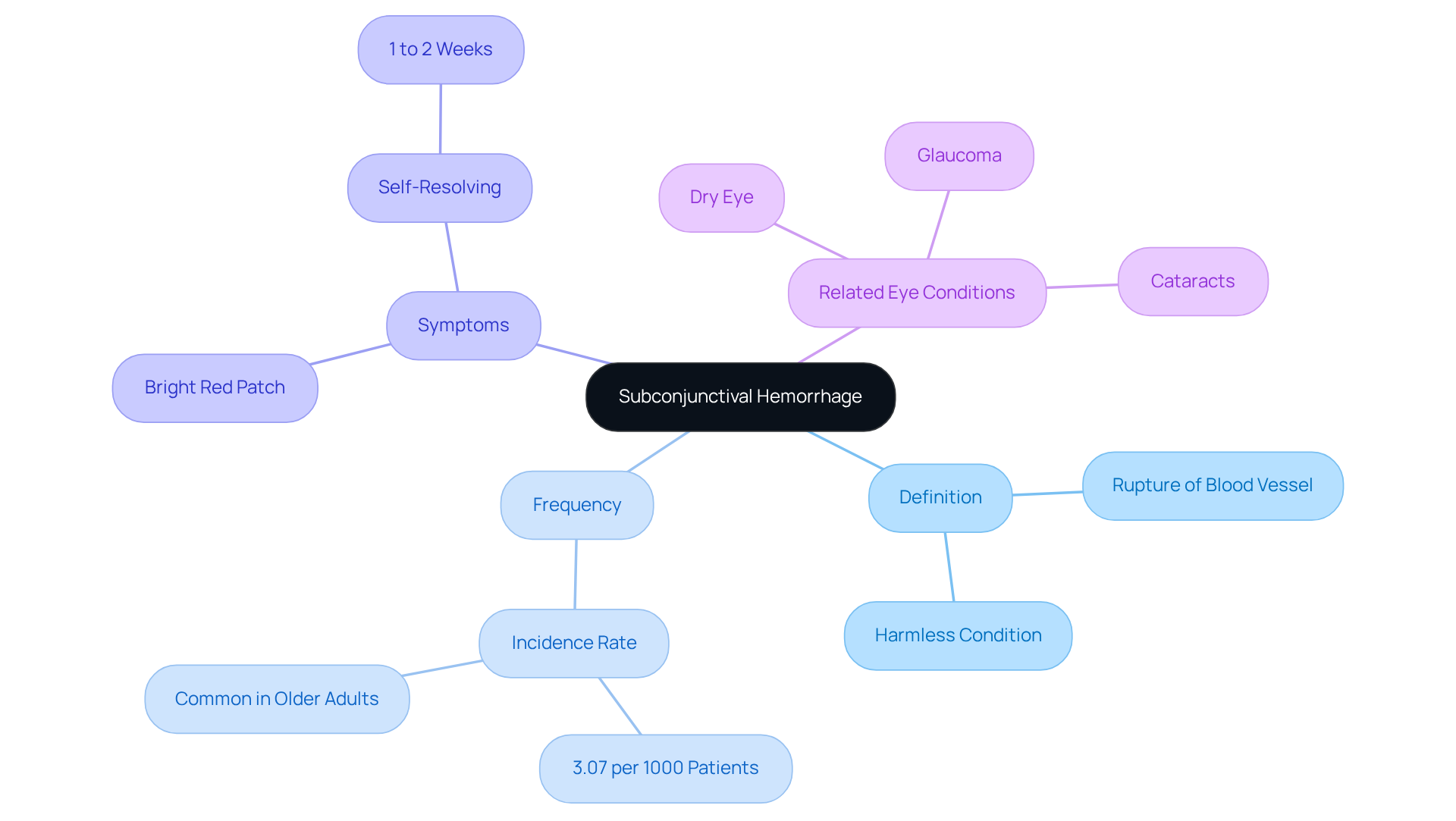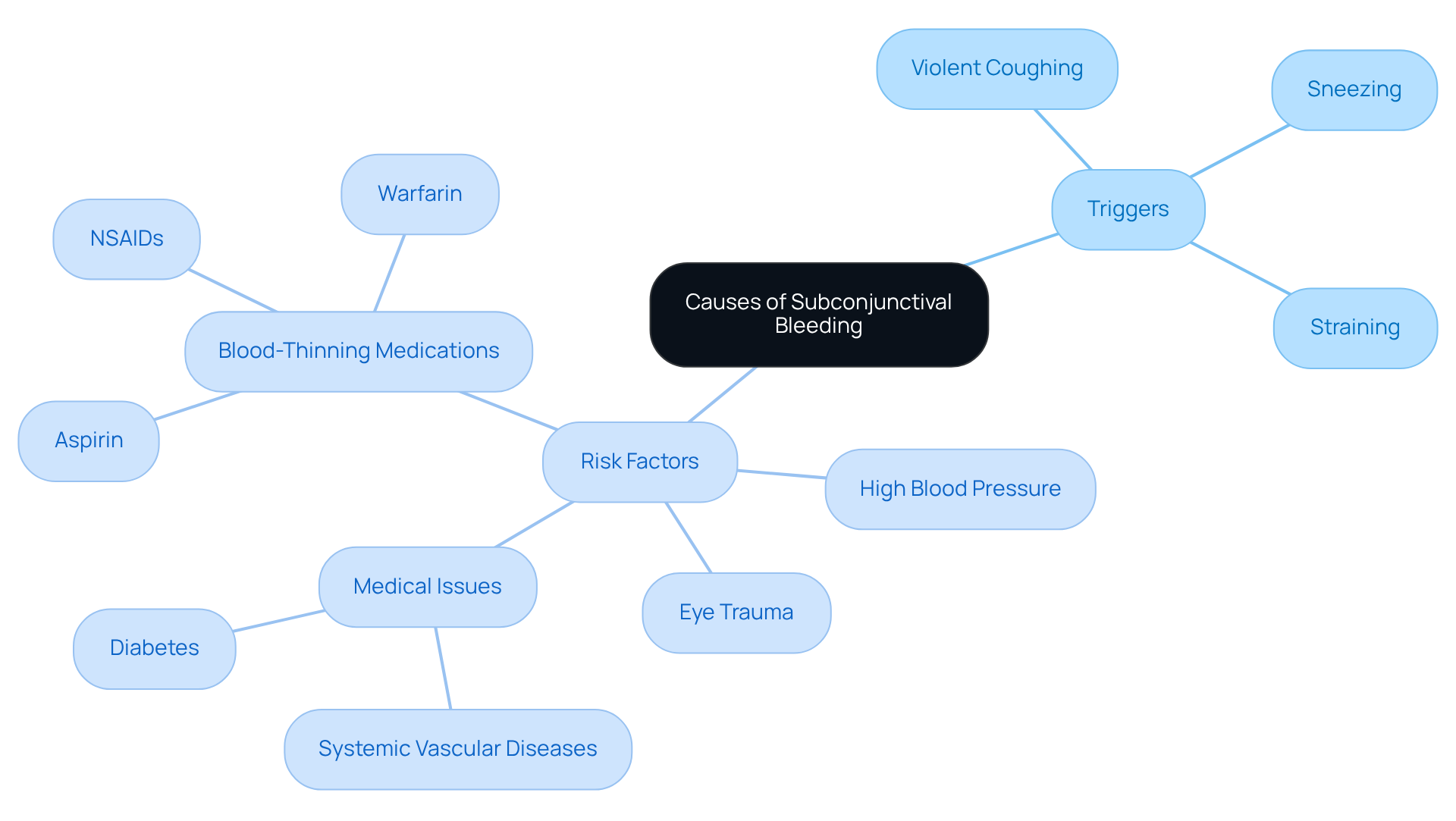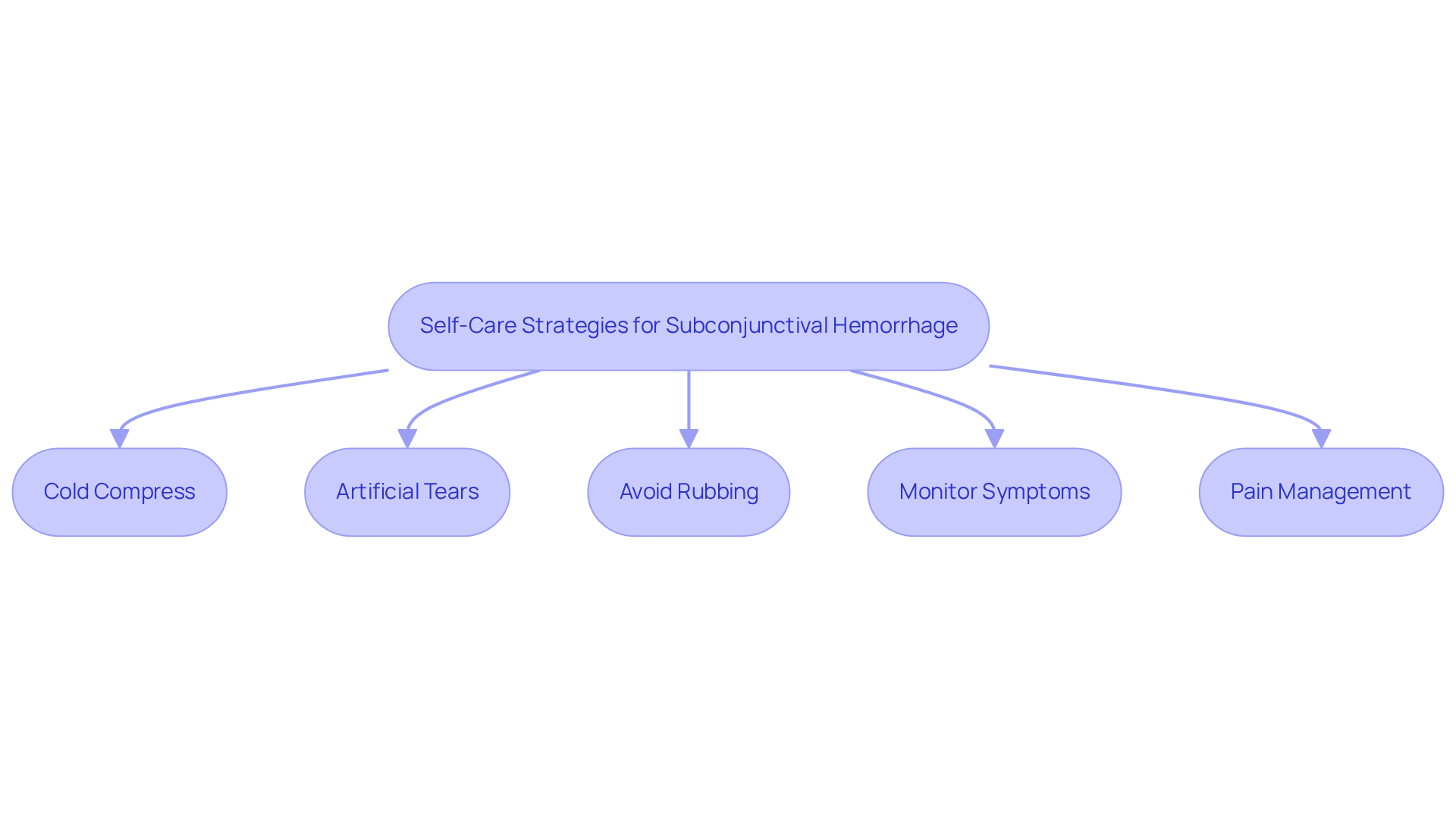Posted by: Northwest Eye in General on July 7, 2025
Overview
We understand that dealing with subconjunctival hemorrhage can be concerning. This article outlines five self-care steps that you can take at home to help manage your condition:
- Apply cold compresses
- Use artificial tears
- Avoid eye rubbing
- Monitor your symptoms
- Effectively manage pain
By following these steps, you can facilitate your recovery and minimize discomfort.
These strategies are supported by expert recommendations, which aim to reassure you during this process. Remember, it’s common to feel anxious about your symptoms. We encourage you to monitor your condition closely and seek medical attention if you notice any potential complications. You are not alone in this journey, and we are here to help you through it.
Introduction
Experiencing a sudden burst of bright red in the white of your eye can be alarming. We understand that this might leave you feeling uncertain about how to respond. Subconjunctival hemorrhage is typically harmless, yet it raises important questions about its causes and the best ways to manage it at home. This guide outlines five essential self-care steps to help alleviate your concerns and promote healing. We are here to empower you to take control of your eye health. What should you do when faced with this unexpected condition? Simple home remedies can indeed make a difference.
Understand Subconjunctival Hemorrhage: Definition and Overview
Subconjunctival bleeding occurs when a small blood vessel under the conjunctiva—the clear membrane covering the white part of your eye—ruptures. This can lead to a bright red patch on the sclera, which may seem alarming at first. However, it’s important to know that this condition is generally harmless. Much like a bruise on your skin, eye bleeding typically resolves on its own within one to two weeks, without requiring medical intervention.
We understand that it can be for the first time. Research indicates that non-traumatic eye bleeding happens in roughly 3.07 per 1000 patients each year, highlighting its relative frequency. This situation is usually benign, which can help ease worries.
At Northwest Eye, we care about your eye health and address a range of issues, including:
We invite you to explore our extensive eye health library, which offers valuable information on various topics related to eye well-being, including subconjunctival hemorrhage self-care. If you have any concerns or need more guidance, we are here to help you through this process. Consider arranging a consultation with a Northwest Eye physician for personalized support and resources.

Identify Symptoms: Recognizing Subconjunctival Hemorrhage
The sight of a red patch on the white part of your eye can be quite startling, but it’s important to know that it is usually harmless. This discoloration typically does not cause pain, swelling, or discharge, and it generally does not impair your vision. While most people report feeling no discomfort, some may experience a or slight irritation in the affected eye. We understand that it can be concerning to notice such changes, and it’s crucial to recognize that if additional symptoms arise—such as pain, changes in vision, or discharge—these could signal a more serious underlying condition that requires prompt medical evaluation.
A countrywide study in Taiwan found that the average [yearly occurrence of eye bleeding](https://journals.plos.org/plosone/article?id=10.1371/journal.pone.0132762) is about 6.5 per 1,000 individuals. Dr. Russel Lazarus reassures us, stating, “While these bright red blood spots look scary, they are usually harmless and often heal on their own.” Understanding these aspects can help alleviate your concerns and guide you on when to seek further medical advice. Remember, we are here to help you through this process.

Explore Causes: Understanding Triggers and Risk Factors
Subconjunctival bleeding can occur due to multiple factors, and we understand that this can be concerning. It is mainly associated with abrupt rises in pressure in the head or neck. Common triggers include:
- Violent coughing
- Sneezing
- Straining
These actions can lead to the rupture of small blood vessels in the eye. High blood pressure is a significant risk factor; chronic hypertension can weaken blood vessels, making them more susceptible to rupture.
Additionally, the use of blood-thinning medications, such as warfarin and aspirin, heightens this risk. Trauma to the eye, whether from direct injury or minor incidents that may not be immediately recalled, can also result in subconjunctival hemorrhage. It’s common to feel anxious about this, especially if you wear contact lenses, as improper handling or prolonged use can strain the eyes and lead to vessel rupture.
Specific medical issues, such as diabetes and systemic vascular diseases, can elevate the probability of encountering this ailment. Fortunately, most eye bleeding incidents resolve naturally within one to two weeks, which can be reassuring. However, if symptoms persist beyond two weeks or are accompanied by pain or vision changes, it’s crucial to consult an eye care professional. Understanding these triggers and risk factors is essential for you, as it enables you to adopt self-care and seek timely medical advice when necessary. We are here to help you through this process.

Implement Self-Care Strategies: Managing Subconjunctival Hemorrhage at Home
We understand that at home can be concerning. Here are some self-care strategies to help you through this process:
- Cold Compress: Apply a cold compress or ice pack wrapped in a cloth to the affected eye for 10-15 minutes several times a day. This method can significantly reduce swelling and discomfort, as cold compresses restrict blood flow, alleviating inflammation. According to the National Eye Institute (NEI), keeping a cold compress on an eye injury for 15 minutes is recommended to avoid frostbite.
- Artificial Tears: Utilize lubricating eye drops (artificial tears) to soothe any irritation or dryness in the eye. This helps maintain comfort during the healing process, especially since dry eye disease affects millions of Americans.
- Avoid Rubbing: It’s common to feel the urge to rub or touch the eye, but please refrain from doing so, as this can worsen the situation and lead to further irritation. Keeping the area undisturbed is crucial for your recovery.
- Monitor Symptoms: Observe the status of the bleeding closely. It is normal for the red spot to change color as it heals, transitioning from bright red to yellowish or brownish over the course of 1-2 weeks. It’s important to note that recovery from eye bleeding may take up to 3 weeks for patients on anticoagulation therapy.
- Pain Management: If discomfort arises, consider using acetaminophen for pain relief. However, avoid aspirin or other blood thinners that may exacerbate bleeding, especially for individuals on anticoagulation therapy, as about 10% of those without known risk factors may encounter a recurrence of eye bleeding. Ann Marie Griff, O.D., emphasizes that cold compresses are a safe, effective home remedy for eye discomfort.
Implementing these strategies can facilitate a smoother recovery process and enhance your overall eye health through proper subconjunctival hemorrhage self-care. We are here to help you through this journey.

Know When to Seek Medical Attention: Signs of Complications
While subconjunctival hemorrhage is generally harmless, we understand that certain signs may cause concern and indicate the need for medical attention. It’s important to seek immediate care if you experience any of the following:
- Vision Changes: Any alterations in vision, such as blurriness or loss of sight, warrant evaluation by a healthcare professional. Blurred vision can be a sign of various eye ailments, including cataracts, diabetic retinopathy, and macular degeneration, which are commonly treated at Northwest Eye. It’s concerning to know that vision impairment affects approximately 8.3 million people in the U.S., and about 4.2 million Americans aged 40 or older have uncorrectable vision impairment. This highlights the importance of addressing any changes promptly.
- Severe Pain: We understand that significant eye pain may suggest a more serious underlying condition and should not be ignored.
- Persistent Symptoms: If the red patch persists or does not improve within two to three weeks, it’s advisable to consult a doctor to rule out complications.
- Signs of Infection: Symptoms such as discharge, increased redness, or swelling around the eye may indicate an infection requiring treatment. With around 1 million Americans developing eye infections annually, recognizing these signs is essential for timely intervention. As Dr. Jane Smith, an ophthalmologist, states, “Prompt attention to any signs of infection can prevent more serious complications.”
In summary, being vigilant about these symptoms can help ensure timely medical intervention and protect your vision. Remember, or eye care professional can provide an accurate diagnosis and appropriate treatment for any concerning symptoms. We are here to help you through this process.
Conclusion
Subconjunctival hemorrhage can be alarming when you first notice a bright red patch on your eye. However, it’s important to understand that this condition is generally benign and tends to resolve on its own. Knowing this can significantly ease your anxiety. With the right self-care strategies, you can manage this condition at home, promoting healing and comfort.
It’s common to feel unsure about what to do. Key points to consider include:
- Recognizing symptoms
- Exploring potential causes and risk factors
- Implementing self-care strategies such as applying cold compresses and using artificial tears
Additionally, being aware of when to seek medical attention is crucial, as certain symptoms may indicate complications that require professional evaluation. By staying informed and vigilant, you can navigate your experience with subconjunctival hemorrhage more confidently.
In light of this information, prioritizing your eye health and awareness is essential. Embracing self-care strategies not only aids in recovery but also empowers you to take control of your well-being. Should any concerning symptoms arise, remember that reaching out to an eye care professional is vital to ensure comprehensive care and protection of your vision. We are here to help you through this process.
Frequently Asked Questions
What is subconjunctival hemorrhage?
Subconjunctival hemorrhage occurs when a small blood vessel under the conjunctiva, the clear membrane covering the white part of the eye, ruptures, leading to a bright red patch on the sclera.
Is subconjunctival hemorrhage a serious condition?
No, subconjunctival hemorrhage is generally harmless and typically resolves on its own within one to two weeks without requiring medical intervention.
How common is subconjunctival hemorrhage?
Research indicates that non-traumatic eye bleeding occurs in roughly 3.07 per 1000 patients each year, highlighting its relative frequency.
What symptoms are associated with subconjunctival hemorrhage?
The primary symptom is a red patch on the white part of the eye, which usually does not cause pain, swelling, or discharge. Some individuals may experience a mild sensation of fullness or slight irritation.
When should I seek medical attention for subconjunctival hemorrhage?
If you experience additional symptoms such as pain, changes in vision, or discharge, these could indicate a more serious underlying condition that requires prompt medical evaluation.
What can I do if I have concerns about my eye health?
If you have concerns or need more guidance regarding eye health, consider arranging a consultation with a Northwest Eye physician for personalized support and resources.






